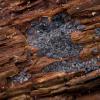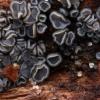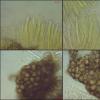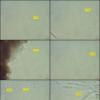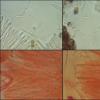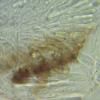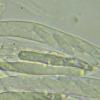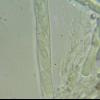
05-01-2020 19:29
 William Slosse
William Slosse
Hallo Forum,I think to have found M. cinerea but I

06-01-2020 10:08
 Blasco Rafael
Blasco Rafael
Hola a todosAlguno de Usttedes conoce este Anamorf

31-12-2019 22:50
 Viktorie Halasu
Viktorie Halasu
Hello forum,first, all the best in new year to eve

05-01-2020 17:00
 Blasco Rafael
Blasco Rafael
Hola a todosHe encontrado unas pequeñas muestras

31-12-2019 10:17
 Andreas Gminder
Andreas Gminder
Dear all,reviewing my collections from Ethiopia, w

04-01-2020 17:19
 Robin Isaksson
Robin Isaksson
I am convinced that this is Pseudombrophila hepati
Mollisia cinerea?
William Slosse,
05-01-2020 19:29
 Hallo Forum,
Hallo Forum,I think to have found M. cinerea but I have doubts because of the septated spores IN the asci.
The species grew on a wet, rotten and decorticated piece of wood of Populus sp.
Reaction in IKI 1-3 and Lugol: negative.
Reaction in Meltzer: asci apically blue and parafphyses jellowing
No margin hairs found
Spores 9.69x2.55um; one-septated; without oildrops
Asci with one-septated spores
Cinerea or 'atlantica'?
Thanks for any suggestion.
William
Hans-Otto Baral,
05-01-2020 20:55

Re : Mollisia cinerea?
Do you have a figure of septate spores in the asci? Not too small to properly seeing it? In M. atlantica the living asci contain septate spores, this is important.
M. atlantica I remember more grey with blackish-brown exterior, not bluish.
Your Lugol must be too diluted (old). But IKI 1-3 means blue?
William Slosse,
05-01-2020 21:19

Re : Mollisia cinerea?
Hallo Otto,
thx for your reaction.
I insert here a picture of the septated spores in the fresh asci.
The underside of the ascocarps is really blackish.
My Lugol could be indeed too old as well as the IKI I bought in Belgium (the label on the flask sais 'Liquide de Baral (IKI 1-3)'). Only the Melzer reagens provoques some reaction as shown on the pictures.
Regards,
William
thx for your reaction.
I insert here a picture of the septated spores in the fresh asci.
The underside of the ascocarps is really blackish.
My Lugol could be indeed too old as well as the IKI I bought in Belgium (the label on the flask sais 'Liquide de Baral (IKI 1-3)'). Only the Melzer reagens provoques some reaction as shown on the pictures.
Regards,
William
Hans-Otto Baral,
05-01-2020 21:38

Re : Mollisia cinerea?
Yes, now I see it. It is not fully clear whether this ascus is turgescent, but at least maybe it was before squashing. If you saw this repeatedly, it may be M. atlantica. We do not have this species in southern Germany, personally I only know it from England.
William Slosse,
05-01-2020 21:57

Re : Mollisia cinerea?
I have a lot of material here, Otto.
Now I prepared a new sporee and tomorrow I wil look again at the asci to have the ultimate prove.
And if you wish I could send you a sample (w.slosse@telenet.be)
Thx, Otto.
Now I prepared a new sporee and tomorrow I wil look again at the asci to have the ultimate prove.
And if you wish I could send you a sample (w.slosse@telenet.be)
Thx, Otto.
Hans-Otto Baral,
05-01-2020 22:01

Re : Mollisia cinerea?
thank you, but I am overloaded.


